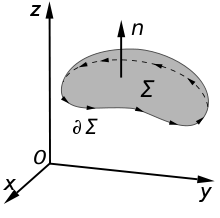| Part of a series of articles about |
| Calculus |
|---|

Stokes' theorem,[1] also known as the Kelvin–Stokes theorem[2][3] after Lord Kelvin and George Stokes, the fundamental theorem for curls or simply the curl theorem,[4] is a theorem in vector calculus on . Given a vector field, the theorem relates the integral of the curl of the vector field over some surface, to the line integral of the vector field around the boundary of the surface. The classical theorem of Stokes can be stated in one sentence:
- The line integral of a vector field over a loop is equal to the surface integral of its curl over the enclosed surface.
Stokes' theorem is a special case of the generalized Stokes theorem.[5][6] In particular, a vector field on can be considered as a 1-form in which case its curl is its exterior derivative, a 2-form.
- ^ Stewart, James (2012). Calculus – Early Transcendentals (PDF) (7th ed.). Brooks/Cole. p. 1122. ISBN 978-0-538-49790-9.
- ^ Nagayoshi, Iwahori (1983). 微分積分学 (Bibun sekibungaku) (in Japanese). Shokabo. ISBN 978-4-7853-1039-4. OCLC 673475347.
- ^ Atsuo, Fujimoto (1979). 現代数学レクチャーズ. C 1, ベクトル解析 (Gendai sūgaku rekuchāzu. C(1), Bekutoru kaiseki) (in Japanese). Baifukan. OCLC 674186011.
- ^ Griffiths, David J. (2013). Introduction to electrodynamics (PDF). Always learning (4. ed.). Boston: Pearson. p. 34. ISBN 978-0-321-85656-2.
- ^ Conlon, Lawrence (2008). Differentiable manifolds. Modern Birkhäuser classics (2. ed.). Boston ; Berlin: Birkhäuser. ISBN 978-0-8176-4766-7.
- ^ Lee, John M. (2012). Introduction to smooth manifolds. Graduate texts in mathematics. Vol. 218 (2nd ed.). New York ; London: Springer. ISBN 978-1-4419-9982-5.

